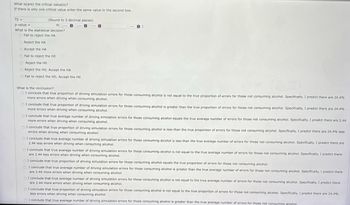
FINANCIAL ACCOUNTING
10th Edition
ISBN: 9781259964947
Author: Libby
Publisher: MCG
expand_more
expand_more
format_list_bulleted
Question
not use ai please don't

Transcribed Image Text:What is (are) the critical value(s)?
If there is only one critical value enter the same value in the second box.
TS =>
p-value=
(Round to 3 decimal places)
PC
What is the statistical decision?
Fail to reject the HA
Reject the HA
Accept the HA
Fail to reject the HO
Reject the HO
Reject the HO; Accept the HA
Fail to reject the HO; Accept the HO
What is the conclusion?
I conclude that true proportion of driving simulation errors for those consuming alcohol is not equal to the true proportion of errors for those not consuming alcohol. Specifically, I predict there are 24.4%
more errors when driving when consuming alcohol.
I conclude that true proportion of driving simulation errors for those consuming alcohol is greater than the true proportion of errors for those not consuming alcohol. Specifically, I predict there are 24.4%
more errors when driving when consuming alcohol.
I conclude that true average number of driving simulation errors for those consuming alcohol equals the true average number of errors for those not consuming alcohol. Specifically, I predict there are 2.44
more errors when driving when consuming alcohol.
I conclude that true proportion of driving simulation errors for those consuming alcohol is less than the true proportion of errors for those not consuming alcohol. Specifically, I predict there are 24.4% less
errors when driving when consuming alcohol.
I conclude that true average number of driving simulation errors for those consuming alcohol is less than the true average number of errors for those not consuming alcohol. Specifically, I predict there are
2.44 less errors when driving when consuming alcohol.
I conclude that true average number of driving simulation errors for those consuming alcohol is not equal to the true average number of errors for those not consuming alcohol. Specifically, I predict there
are 2.44 less errors when driving when consuming alcohol.
I conclude that true proportion of driving simulation errors for those consuming alcohol equals the true proportion of errors for those not consuming alcohol.
I conclude that true average number of driving simulation errors for those consuming alcohol is greater than the true average number of errors for those not consuming alcohol. Specifically, I predict there
are 2.44 more errors when driving when consuming alcohol.
I conclude that true average number of driving simulation errors for those consuming alcohol is not equal to the true average number of errors for those not consuming alcohol. Specifically, I predict there
are 2.44 more errors when driving when consuming alcohol.
OI conclude that true proportion of driving simulation errors for those consuming alcohol is not equal to the true proportion of errors for those not consuming alcohol. Specifically, I predict there are 24.4%
less errors when driving when consuming alcohol.
I conclude that true average number of driving simulation errors for those consuming alcohol is greater than the true average number of errors for those not consuming alcohol.
Expert Solution
This question has been solved!
Explore an expertly crafted, step-by-step solution for a thorough understanding of key concepts.
Step by stepSolved in 2 steps

Knowledge Booster
Similar questions
- Please do not rely too much on chatgpt, because its answer may be wrong. Please consider it carefully and give your own answer. You can borrow ideas from gpt, but please do not believe its answer.Very very grateful!Please do not rely too much on chatgpt, because its answer may be wrong. Please consider it carefully and give your own answer. You can borrow ideas from gpt, but please do not believe its answer.Very very grateful!arrow_forwardPlease do not rely too much on chatgpt, because its answer may be wrong. Please consider it carefully and give your own answer. You can borrow ideas from gpt, but please do not believe its answer.Very very grateful!Please do not rely too much on chatgpt, because its answer may be wrong. Please consider it carefully and give your own answer. You can borrow ideas from gpt, but please do not believe its answer.Very very grateful!arrow_forwardExplain with an example why any computer-based application control cannot function on its own and why its effectiveness depends on a set of general controls.arrow_forward
arrow_back_ios
arrow_forward_ios
Recommended textbooks for you

 AccountingAccountingISBN:9781337272094Author:WARREN, Carl S., Reeve, James M., Duchac, Jonathan E.Publisher:Cengage Learning,
AccountingAccountingISBN:9781337272094Author:WARREN, Carl S., Reeve, James M., Duchac, Jonathan E.Publisher:Cengage Learning, Accounting Information SystemsAccountingISBN:9781337619202Author:Hall, James A.Publisher:Cengage Learning,
Accounting Information SystemsAccountingISBN:9781337619202Author:Hall, James A.Publisher:Cengage Learning, Horngren's Cost Accounting: A Managerial Emphasis...AccountingISBN:9780134475585Author:Srikant M. Datar, Madhav V. RajanPublisher:PEARSON
Horngren's Cost Accounting: A Managerial Emphasis...AccountingISBN:9780134475585Author:Srikant M. Datar, Madhav V. RajanPublisher:PEARSON Intermediate AccountingAccountingISBN:9781259722660Author:J. David Spiceland, Mark W. Nelson, Wayne M ThomasPublisher:McGraw-Hill Education
Intermediate AccountingAccountingISBN:9781259722660Author:J. David Spiceland, Mark W. Nelson, Wayne M ThomasPublisher:McGraw-Hill Education Financial and Managerial AccountingAccountingISBN:9781259726705Author:John J Wild, Ken W. Shaw, Barbara Chiappetta Fundamental Accounting PrinciplesPublisher:McGraw-Hill Education
Financial and Managerial AccountingAccountingISBN:9781259726705Author:John J Wild, Ken W. Shaw, Barbara Chiappetta Fundamental Accounting PrinciplesPublisher:McGraw-Hill Education


Accounting
Accounting
ISBN:9781337272094
Author:WARREN, Carl S., Reeve, James M., Duchac, Jonathan E.
Publisher:Cengage Learning,

Accounting Information Systems
Accounting
ISBN:9781337619202
Author:Hall, James A.
Publisher:Cengage Learning,

Horngren's Cost Accounting: A Managerial Emphasis...
Accounting
ISBN:9780134475585
Author:Srikant M. Datar, Madhav V. Rajan
Publisher:PEARSON

Intermediate Accounting
Accounting
ISBN:9781259722660
Author:J. David Spiceland, Mark W. Nelson, Wayne M Thomas
Publisher:McGraw-Hill Education

Financial and Managerial Accounting
Accounting
ISBN:9781259726705
Author:John J Wild, Ken W. Shaw, Barbara Chiappetta Fundamental Accounting Principles
Publisher:McGraw-Hill Education